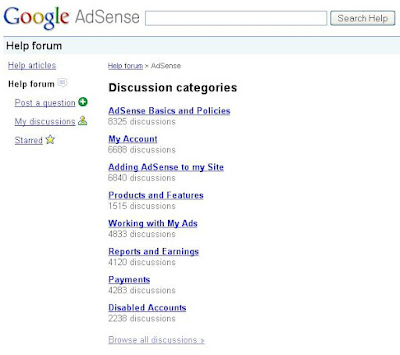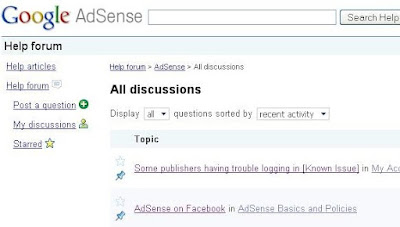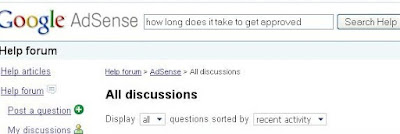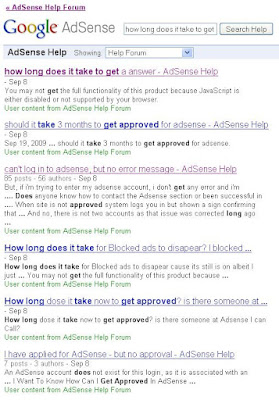 If you want to get answers that help resolve your problems or questions in the AdSense Help Forums, there are some things you can and should do before you start posting to the forums.
If you want to get answers that help resolve your problems or questions in the AdSense Help Forums, there are some things you can and should do before you start posting to the forums.First, you need to read the AdSense Support Forums Terms of Service. You shouldn't post profanity, or advertising. You also must not use your website address as a signature. This is considered advertising. You can, however, use your Google Profile to list your websites if you so choose. Posters can access your Google Profile from your nickname on the forums. (You may post your website url in your question if it's necessary to the question, just not as a signature.)
Next, at the Help Forum "home page" you'll see a list of discussion categories. These links will bring up questions in each category, filtering out other categories. It's helpful to read through other postings, because often your question will already have been answered in someone else's post. On the right side of the page is a listing of "popular" discussions that may already answer your question as well.

At the bottom of the home page is a link to "browse all discussions". When you click on this you get all the discussions and threads in the forum, including some you should check before you begin a new post. At the top of the help forum discussions are "pinned topics". These are topics posted by AdSense/Google Employees, and often will include things like current problems (ie: "Known Issues"). If there are system bugs that many publishers are experiencing, you will probably find it here in the pinned section, unless it has already been resolved. Many duplicate complaint posts could be avoided if people would check the pinned topics first.
 Another thing to do before posting your own topic is to search the forums. Just think about where you are. You are in a forum hosted and run by Google. And who are Google? They're the people who are pretty well known for their search engine, which means they do "search" extremely well. You should make use of this. Type your problem into the search bar at the top and click the "search help" button.
Another thing to do before posting your own topic is to search the forums. Just think about where you are. You are in a forum hosted and run by Google. And who are Google? They're the people who are pretty well known for their search engine, which means they do "search" extremely well. You should make use of this. Type your problem into the search bar at the top and click the "search help" button.
Look through the results and see if your problem (or a similar complaint or question) is there, and if it has been answered or not.
 After doing all of that, if you still have a question that hasn't been asked or that is more specific than what's listed, then go ahead and post your question. Click the "post a question" link on the left menu.
After doing all of that, if you still have a question that hasn't been asked or that is more specific than what's listed, then go ahead and post your question. Click the "post a question" link on the left menu.How to Post an Effective Question
If you want an answer to your question, then you need to post a question that addresses your issue as clearly as possible and contains details. Questions like "I can't get approved" or "What's wrong with my website" or "Why?" are really not going to get you helpful answers.
Don't:
- post questions unrelated to AdSense problems
- post the full question in your title
- post one word questions (why? when? what? help!)
- post the same question over and over again (simply edit your question or post a "bump" and it will move back toward the top of the forum again)
- post "bumps" every minute
- post without checking the help articles (link is in left sidebar)
- post in any language except english (there are help forums available in other languages - down at the bottom of the page linked here is a drop down box with the avalilable languages for help forums)
- post spam (this will get you banned from the forum)
- post your email address, publisher ID or personal details
- post your website address unless the help you are asking for is AdSense related
- post personal insults and profanity
- post links to pornographic websites
- post adlinks in the forum
- use a title related to your question
- post a full explanation and question within the body of the post. If your question doesn't make sense, we can't answer it properly without asking further questions.
- use the search function before posting
- read the help articles before posting
- include your website url if you think people need to look at your site to offer help (this is necessary for questions on ads that won't display, help with disabled accounts, ad placements, ads that aren't related to your content etc.)
- check your posts for answers instead of posting again
- try to be patient. There are a lot of questions every day and not that many of us to answer them.
- try not to take your anger a frustration out on the people answering your questions. Almost none of them are employed by Google or AdSense. Most of them are volunteers who are publishers, just like you. Unless a responding poster has "Google Employee" by/under their name, they are just ordinary folks trying to help others.
 questions. In the menu bar at the left is a link for "My Discussions" this will take you to your profile where all the questions you've asked are listed. You can click the link for the post you want and it will take you to that thread.
questions. In the menu bar at the left is a link for "My Discussions" this will take you to your profile where all the questions you've asked are listed. You can click the link for the post you want and it will take you to that thread.If you post a question that doesn't get answered, amend your original question to bring it back to the front of the forum where people can see it again. Posting the same question multiple times simply makes everyone annoyed. There are some types of questions that we just can't resolve in the forums, so you may not get an answer.
Please note that questions related specifically to how to place your AdSense code into your website are often more related to:
- the specific website creator you are using
- the webhosting or blog service you are using
Please try to remember that as AdSense publishers most of the volunteers have experienced similar problems and have experienced the same frustrations as you have. Please don't come into the forums with a nasty attitude towards those who are trying to help you. All this will do is make the volunteers reluctant to try and help you.
You can express your frustration, just don't make it a personal attack on your helpers. That won't resolve anything.
If your question is related to other Google services (YouTube, gmail, google search, blogger, etc.) then you need to ask your question in the help forum for the related product. You can start here at the "Getting Started with Google Help" page, or if you want to look at all the help forums and groups available for Google services and products you can do that here.














